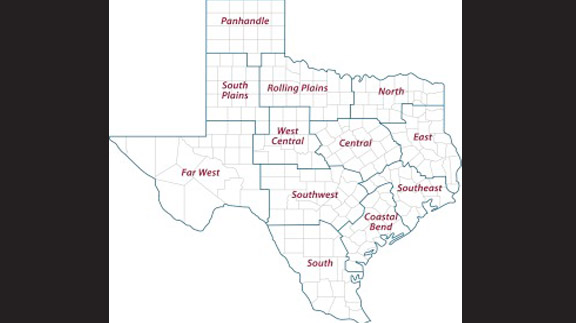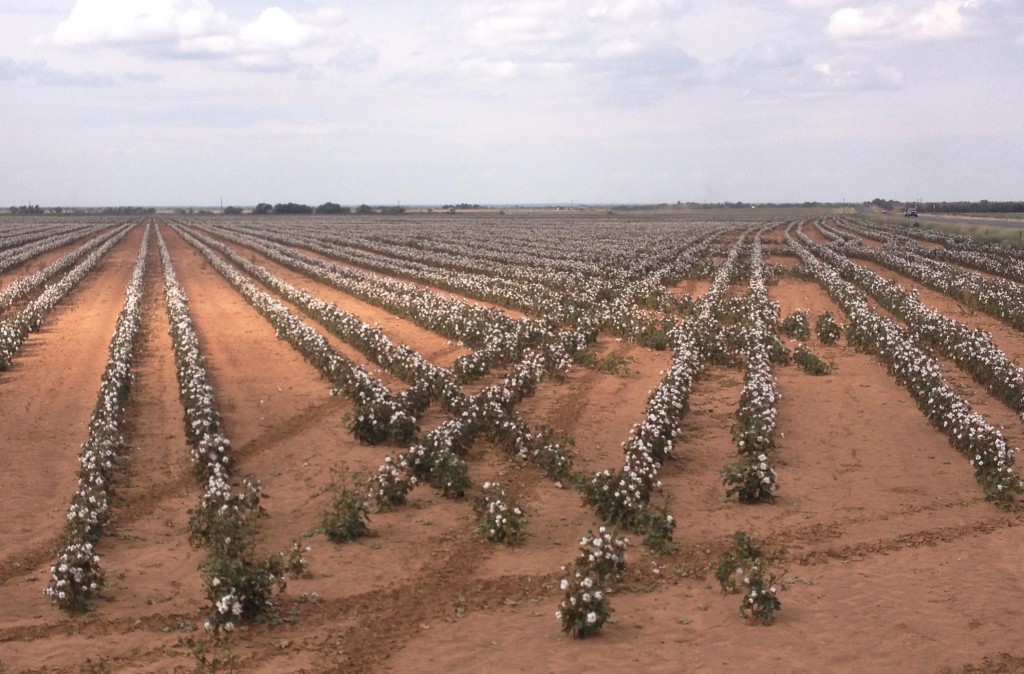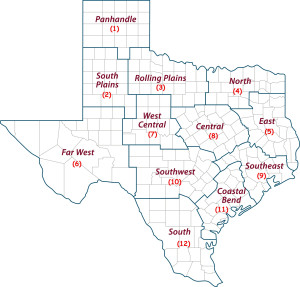Farm & Ranch
Texas crop, weather for Oct. 14, 2015

By: Robert Burns
Warm fall allows Texas High Plains and Rolling Plains cotton to mature
Writer: Robert Burns, 903-834-6191, [email protected]
COLLEGE STATION – The warmer fall weather has greatly helped Texas cotton in the Rolling Plains and High Plains areas catch up on maturity, said a Texas A&M AgriLife Extension Service agronomist.
“Overall, from Haskell and Knox counties, and up to Wilbarger and Motley counties, dryland cotton is definitely going to make an above average crop, said Dr. Gaylon Morgan, AgriLife Extension state cotton specialist, College Station.
Morgan recently inspected Rolling Plains cotton fields and talked with producers at numerous cotton field days.
Download or preview a two-minute MP3 audio version of Texas crop, weather for Oct. 14, 2015
Further (farther) south, into the San Angelo area, most dryland cotton was “burned up” due to missing multiple June and July rains, Morgan said.
But overall, the Rolling Plains crop turned out to be in much better shape than was expected a few months ago, he said.
“Considering the type of spring we had, with late planting, there was a lot of concern about cotton not being able to finish out,” Morgan said. “But this open fall with 90-plus degree temperatures and sufficient heat units allowed the crop to mature and open-up, and we will hopefully be able to harvest this crop before the wet weather when the predicted El Niño arrives.”
In the South Plains, cotton is looking promising, Morgan said, after consulting with Mark Kelley, AgriLife Extension agronomist, Lubbock. There, as in the Rolling Plains, the warm weather helped cotton mature.
“We’re expecting three-quarters of a bale per acre on some of the dryland cotton and as much as two-plus bales on the highly irrigated cotton,” Morgan said.
Because of lack of rain, some South Plains dryland cotton burned-up as it did in the southern Rolling Plains, he said. As usual, the rainfall this summer was variable across the High Plains, and the exact number of acres lost to drought has yet to be determined.
“But it is safe to say that yields were certainly much reduced by the lack of rain late in the summer,” Morgan said. “There were good rains in June and July, but they really needed some more rain in August to finish out the dryland crop. The irrigated guys did pretty good because of the June and July rains; they were able to retain the fruit load through August with irrigation.”
“Producers in the Rio Grande Valley were very pleased with their dryland and irrigated yields this year,” Morgan said. “It was a tough year getting cotton planted and harvested due to rain, but the yields were good. Moving up the coast, yields were highly variable depending on field drainage and planting date. Better-drained fields that survived the flooding conditions had some good yields.”
It was a different story for cotton in the Upper Gulf Coast and Blacklands, he said.
“The yields were below the five-year average,” Morgan said. “The excessively wet spring followed by no rain in July or August really hurt the yields. Harvesting ran over a month behind normal, and many farmers just wanted the 2015 season to be over.”
AgriLife Extension district reporters compiled the following summaries for the reporting period of Oct. 4-12:
Central: Soil moisture, rangeland, pastures and crops were all rated in fair condition. Overall livestock conditions were good. Dry conditions slowed cotton growth at the end of the growing season. With no rain, farmers were either delaying planting wheat and oats or dry-planting the crops. The dry weather also delayed the planting of canola. Livestock were still in good condition. Many producers were feeding extra protein to cattle. Pasture quality was declining. Cattle prices dropped a little. Bermuda grass stem maggots and armyworms were infesting fields.
Coastal Bend: The region had above average temperatures and mostly dry conditions. More rain was needed to improve soil moisture. Growers are doing post-harvest fieldwork. Some pecan harvesting began. Producers were harvesting fall hay. Dry conditions delayed the planting of winter pasture in some areas. Fall calves were being born, and cows were in good shape.
East: Drought conditions worsened. Ponds and creeks were going dry. The majority of counties reported subsoil and topsoil as short, with a few reporting both as very short. Only five counties reported adequate subsoil and topsoil moisture. Forages were showing signs of severe stress. Panola County has had 95 days without substantial moisture. The dryer conditions would have been worse if not for the earlier summer rains that made good grazing and haying possible for most of the later summer. Winter pasture planting was delayed as producers waited on rain. Pastures were dry and grass was short. Cattle remained in fair to good condition, but some producers were already supplementing cattle with hay. Fall calving was underway. Weaning and selling of market-ready calves and cull cows continued. In Gregg County, feral hog activity was low. Smith County, however, reported feral hog activity had picked up.
Far West: Cotton harvesting sped up until Oct. 8, then rains came and harvesting was halted. Rainfall totals ranged from less than 1 inch in Terrell County to as much as 6 inches in Loving and Winkler counties. Cooler temperatures were the norm across the district. Hudspeth County chile crops were close to harvest. Some producers had alfalfa on the ground during the recent rains. Sugarcane aphids were still present in Glasscock County and were being closely monitored. Pasture and rangeland conditions across the district varied from fair to very poor. Topsoil and subsoil moisture was mostly adequate.
North: The region had another rainless week, and topsoil moisture was short to very short. The dry weather pattern since late spring was taking a toll on all agriculture in the region. Nighttime temperatures cooled off significantly, but daytime highs were still in the low 90s. Pastures and rangeland conditions continued to decline. Some producers were feeding hay to offset poor forage conditions. Some winter pastures were planted, but due to lack of ground moisture they had yet to emerge. Those who dry planted their wheat and oats early now wished they had waited. Grain sorghum producers wrapped up harvesting, with yields mostly low to very low. Spring rains filled ponds to overflowing, but levels were rapidly dropping with the hot days. Horn fly populations were high. Feral hogs were active. Armyworms were a problem.
Panhandle: The region had near average temperatures for most of the reporting period. Most areas received some rain, but soil moisture continued to be rated mostly short. In Collingsworth County, the rain benefited newly planted wheat, but it stalled peanut and cotton harvesting. Much of the county’s peanut crop had been dug, and producers were waiting for the crop to cure before thrashing. Cotton harvesting began slowly; most fields caught up on maturity despite late planting. In Dallam and Hartley counties, the cool, wet weather stopped grain sorghum and corn harvesting. The pumpkin harvest continued, but dry weather was needed to resume harvest of other crops. Most stocker cattle producers were content to keep cattle on grass rather than market them. Recent rains caused pastures to green up. In Deaf Smith County, rainy weather also halted harvesting. The corn harvest was about half over, with yields below average because of hailstorm damage. Corn passed over by hail and wind was giving good yields, averaging 250 bushels per acre and more. Grain sorghum yields were above average, but many fields were not harvested yet. Producers were planting winter wheat where they could get in the fields. Earlier planted wheat looked good. There was still grasshopper pressure on the young wheat, but it was tolerable. Sunflowers were yet to be harvested. Many sunflower fields had hail damage, which will reduce overall yields. Hemphill County has had 1 inch to 1.6 inches of much needed rain. Cow-calf operators were busy weaning and shipping spring calves. Stockers were ready to graze on wheat, but it will be at least a month before there is much grazing available.
Rolling Plains: Cooler weather prevailed, but the region still needed rain. Pastures and rangeland were in poor condition due to lack of moisture the last several weeks. Earlier rain caused grasses and forages to grow quickly, but when the rains stopped, growth ceased. Wildfires popped up in some areas because of the dry conditions. Fall cattle work began with ranchers weaning spring calves. Cotton bolls were opening rapidly. Cotton producers defoliated some cotton, and harvesting was expected to begin in a week or two. Cotton was in excellent condition in the spring and early summer, but the lack of moisture resulted in some dryland fields to “burn up,” and yields did not look promising. Farmers were hesitant to plant wheat due to dry soil conditions, and earlier planted wheat that emerged was attacked by armyworms.
South: The region had mild temperatures, with some areas receiving substantial rain. The northern part of the region received rain but most accumulations were not significant. Cotton harvesting wrapped up, and early-planted peanuts were being dug. Producers began planting wheat and oats. Rangeland and pasture conditions throughout the northern counties remained good to fair. Supplemental feeding of livestock increased. Body condition scores of cattle remained fair. Soil moisture was short to very short except for La Salle County where it was mostly adequate. In the eastern part of the region, what little cotton that was left in the fields was harvested. Local livestock markets saw an increase in offerings during the last few weeks, with runs of over 500 head. Live Oak County cattle prices declined significantly, as they had done every week for the last six weeks. Five-hundred pound steers were reported at $1.50 per pound, compared to $2.20 a pound during August. Soil moisture was 30 to 40 percent adequate in Duval County, 50 to 80 percent very short in Jim Wells County and 70 percent short in Kleberg and Kenedy counties. In the western part of the region, some areas received heavy rains, with accumulations of 2.5 to 7 inches. The rains will greatly improve native range and pastures, and producers expected to be able to reduce supplemental feeding of livestock. The rain will also benefit dryland oats and wheat. Cabbage, spinach and onion producers expected to save on irrigation costs. Soil moisture conditions were short to very short in Dimmit and Maverick counties and surplus in Zavala County. In the southern part of the region, fall crops progressed well with some vegetables being irrigated. Hay baling continued. Livestock were in good condition. In Starr County, fall vegetable planting preparations and hay baling were ongoing. Soil moisture was 70 percent short in Cameron County and 90 percent adequate in Starr County.
South Plains: Most of the region received rain, with accumulations ranging from 0.4 inch to more than 2 inches. The rains halted field operations and some cotton harvesting for a while but were welcomed by those who had already planted winter wheat. Floyd County producers were slowly starting to harvest cotton. Most producers only recently sprayed fields with harvest aids so it will be another week or so before the harvest really gets rolling. Bailey County received 1.7 inches of rain. Cochran County subsoil and topsoils were saturated by the rain, and all harvesting was stopped due to the wet conditions. Hockley County producers were busy harvesting grain sorghum, with most seeing average and above average yields. They were also harvesting corn, but the cotton harvest was a couple of weeks away . Lubbock County got more than 2 inches of rain in some areas. About 25 percent of the cotton in the county had been defoliated but only about 5 percent harvested. Area gins had ginned from a few hundred to a few thousand bales. The Garza County cotton harvest began on a limited basis but was interrupted by rain on Oct. 8. Cotton yields were expected to be somewhat better than earlier expected due to warmer than average weather. Mitchell County rains allowed producers to start planting winter wheat but it came a little late for dryland cotton. Scurry County only received sparse amounts of rain, and more was needed for all aspects of agriculture.
Southeast: Soil moisture varied widely but was mostly in the short to very short range with very short being the most common. The exception was San Jacinto County with 100 percent adequate soil moisture. Rangeland and pasture ratings were mostly fair to poor, with poor ratings being the most common. The region remained hot and dry. In Walker County the dry conditions delayed the planting of cool-season forages. Wildlife plots were dusted in – planted in dry soil – with the hope of rain coming soon. The Brazos County cotton harvest was nearly completed. Waller County ranchers were still cutting and baling hay. Stock-water tank and river levels continued to drop. Brazoria County didn’t receive any rain, but overall the agricultural conditions were good. In Fort Bend County, the dry weather allowed most producers to finish picking cotton, and hay producers to cut and bale. In Galveston County, water from early rains was still standing in some fields, which delayed hay harvesting.
Southwest: Warm and dry conditions persisted. Cooler temperatures and light showers moved through the region. Crops remained in stable condition, and pastures were on the mend. Producers were waiting on more moisture before planting winter annuals. Pasture and rangeland quality was declining. Livestock producers were providing supplemental feed to cattle.
West Central: The region was mostly dry and warm all week. Nights were mild. The dry conditions coupled with low humidity caused extremely high wildfire danger. A few scattered showers occurred in parts of the region but were not enough to improve drought conditions. Producers were preparing fields for small-grain planting. Some producers dry planted wheat and oats, but most were expected to wait for adequate moisture. Cotton neared maturity. Producers began to apply defoliants. Limited cotton harvesting began. Rangeland and pastures were severely drought stressed. All forage growth was slow due to lack of rain. Supplemental feeding of livestock was started early due to poor grazing conditions. Stock-tank water levels further dropped.
-30-
Find more stories, photos, videos and audio at http://today.agrilife.org
Farm & Ranch
Acorn Toxicity

By Barry Whitworth, DVM, MPH
With the prolonged drought, most pastures in Oklahoma end up in poor condition. With the lack of available forage, animals may go in search of alternative foods.
If oak trees are in the pastures, acorns may be a favorite meal for some livestock in the fall. This may result in oak poisoning.
Oak leaves, twigs, buds, and acorns may be toxic to some animals when consumed.
To read more, pick up a copy of the November edition of North Texas Farm & Ranch magazine, available digitally and in print. To subscribe by mail, call 940-872-5922.

Farm & Ranch
Silver Bluestems

By: Tony Dean
There are a handful of grasses on North Texas grazing lands ranchers need to know, not because they are highly desirable, but rather because they are not of much value. I call them “decom” plants, which is am acronym for “Don’t Ever Count On Me.” Silver bluestem is a “decom” grass.
Silver bluestem is a perennial which grows in all areas of Texas. It can survive in almost all soil types, and in full sun conditions or in semi shade. It grows up to three feet tall and is easily recognized with the presence of the white fuzzy seed head. Also, one of the identifying characteristics of Silver bluestem is a bend in the stems at each node, causing the plants to take on a rounded shape as they mature.
To read more, pick up a copy of the November edition of North Texas Farm & Ranch magazine, available digitally and in print. To subscribe by mail, call 940-872-5922.

Farm & Ranch
Meanwhile Back At The Ranch

By: Rayford Pullen
Fall is here which means winter is closing in on us and before we officially get into winter, we need to make sure our factories are either producing or will be producing in a few months.
We have been pregnancy testing our cows this fall and if they are not bred or nursing a calf, we are bidding them adios. With annual costs somewhere between $900.00 and $1,000.00 per cow, those cows not producing a live weaned calf are costing us quite a bit.
To read more, pick up a copy of the November edition of North Texas Farm & Ranch magazine, available digitally and in print. To subscribe by mail, call 940-872-5922.
-

 Country Lifestyles2 years ago
Country Lifestyles2 years agoScott & Stacey Schumacher: A Growth Mindset
-

 Country Lifestyles8 years ago
Country Lifestyles8 years agoStyle Your Profile – What your style cowboy hat says about you and new trends in 2017
-

 HOME8 years ago
HOME8 years agoGrazing North Texas – Wilman Lovegrass
-

 Equine1 year ago
Equine1 year agoThe Will to Win
-

 Country Lifestyles5 years ago
Country Lifestyles5 years agoAmber Crawford, Breakaway Roper
-

 Outdoor9 years ago
Outdoor9 years agoButtercup or Primrose?
-

 Country Lifestyles8 years ago
Country Lifestyles8 years agoJune 2016 Profile – The man behind the mic: Bob Tallman
-

 Country Lifestyles8 years ago
Country Lifestyles8 years agoDecember 2016 Profile, Rusty Riddle – The Riddle Way






